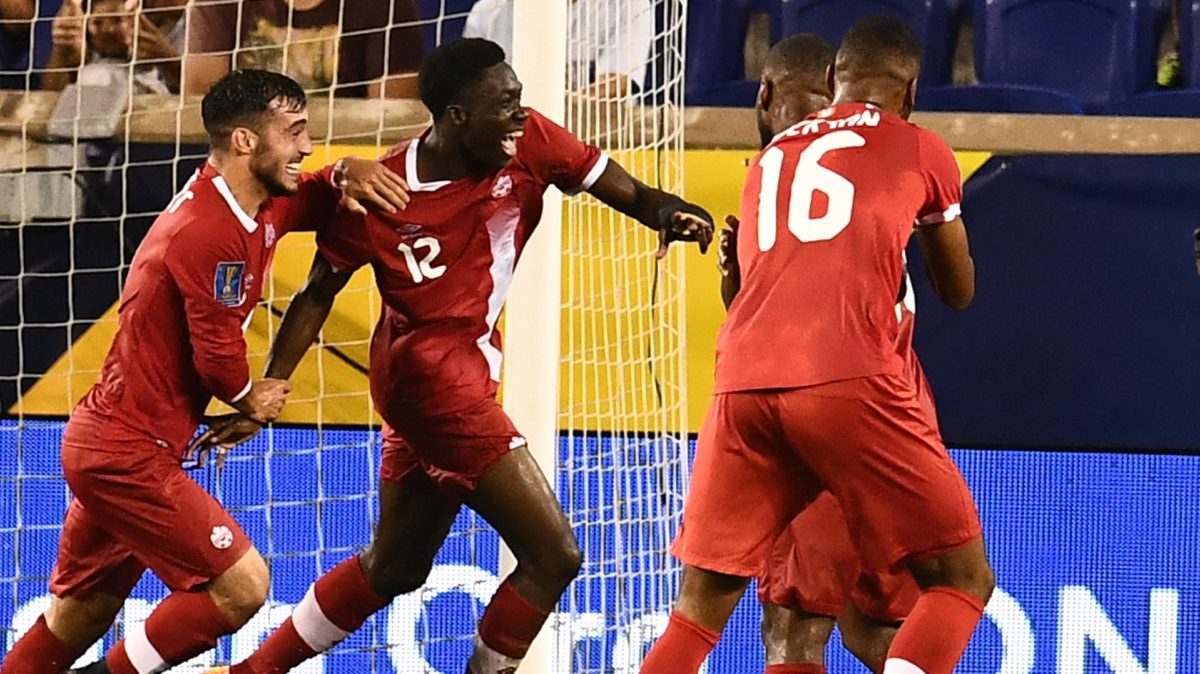John Herdman knew what he was getting into when he took over the Canada men’s national team in January. Coming off a successful seven-year stint with the women’s team, the Englishman already was familiar with the structure of the game in the country, the academies and, he thought, the player pool.
Then he and his staff started digging into the group of more than 3,000 professional players eligible for the team, and he began to realize he may have been sitting on an untapped wealth of young talent.
“The list of names started to come up and you started to realize we had a lot of youth players playing in top academies across Europe,” Herdman told Goal. “While our MLS academies are doing a fantastic job also, we’d see players that were competing week-in week-out in training environments and playing on weekends against top, top European youth teams.
“It became quite enlightening. You started to realize you’ve got players at Auxerre, Olympique Lyon, Gent to name but a few. It was exciting to see what we actually had in our system.”
Between players in prestigious youth systems and rising stars like Bayern Munich summer signing Alphonso Davies, Canada quietly has assembled the most exciting generation of stars it’s ever had and is working on developing more with the creation of a domestic league and continued advances in local academies. With the North Americans set to begin Concacaf Nations League play Sunday against the U.S. Virgin Islands, it’s clear their expectations of what they can do with this talent is sky high.
The successful 2026 bid of Canada, the United States and Mexico was seen by many as Canada’s only chance to return to the World Cup for only the second time in its history.
Herdman, though, believes that qualification in 2022 is a realistic goal.
“There are parts of this team that I’m really comfortable with when I look to the future and I’m projecting out four years time and we’re in a World Cup playing against tough opposition, top opposition, which of the players are going to be able to cope with that level of competition now or in the future,” Herdman said. “We’re starting to look at that now with some of the selections.”
You can’t blame Herdman for dreaming. Davies, a winger for the Vancouver Whitecaps who captured the eyes of Bayern Munich with his incredible ball control and speed, has the potential to be the country’s biggest-ever star.
Jonathan David, an 18-year-old forward, jumped out to an incredible start with Gent this season and earned his first senior national team call-up having scored four goals in four league games, in addition to finding the back of the net in both legs of a Europa League playoff against Polish side Jagiellonia.
Cyle Larin, 23, looked like he would be the forward of the future for Canada and still has a chance to be that if he can hold off competition from his teammates. He scored a hat trick for Besiktas in a Europa League qualification match against B36 of the Faroe Islands and has been involved against the stiffer competition in the Super Lig as well.
Liam Millar has been in the Liverpool system for several years. The 18-year-old currently is with the U-23s and recently scored against Manchester City’s U-23s in his first start of the season.
At the back there is less for fans to get excited about – for now. Though he’s currently playing in the Serbian second division, plenty involved in Canadian soccer are high on 20-year-old Derek Cornelius, while 19-year-old right back Zachary Brault-Guillard is rising through the ranks with Lyon.
Brault-Guillard was born in Haiti and grew up between Montreal and Lyon but is hardly the only player with a multicultural upbringing or eligibility for another country. Recruiting was a big part of former Canada boss Octavio Zambrano’s strategy, and Herdman has followed suit. Players like Brault-Guillard, goalkeeper Alessandro Busti, midfielder Kris Twardek, and even Davies and David were or still are eligible to represent another country at the senior level. But many players have been pulled in with the multicultural feel of the team an enticing factor.
“What led me to choose to play for Canada is definitely the pride of being Canadian, and in addition that the Canadian football structure,” Juventus Primavera prospect Busti said in an email. “It is absolutely a virtue for Canada that there are many players around Europe because they bring different cultures, and the techniques and tactics they learn can help their teammates in the national team.”
That desire to be a part of the setup is what Herdman is looking for in his potential recruits. The coach has been in contact with Barcelona B attacker Ballou Tabla with the Ivory Coast-born, Montreal-raised teenager still not sure where his international future will be. While he could have a place with Canada, the 43-year-old coach says commitment is critical.
“This isn’t jumping on an airplane and having a six-course meal and a limo ride and some swag from Canada soccer and all the rest of the things that coaches might have tried before. This is genuinely working with the player to help them make the right decisions for themselves, and that might be Ivory Coast,” Herdman said. “I think that’s part of our commitment as coaches. We have to look at the best for these players and give them the time to work through things. It’s got to be the right decision for them. It has to feel like it’s time to come and play for Canada.”
If Canada does bring it all together, if it achieves its lofty goals of being relevant on the global soccer landscape, this summer’s Toulon Tournament may be looked at as a starting point. Herdman and assistant coach Mauro Biello felt they were playing from behind, putting together a team in a few months that would have only a handful of training sessions together. Canada ended the tournament with a win and two draws, falling a point short of advancing out of a group that included Portugal, Japan and Turkey.
While their on-field objective wasn’t met, the goal of bringing as many elements from this promising generation together worked out. Twardek previously was involved with the Czech Republic youth system and said there was a noticeable difference between the vibe in that team and Canada.
“In the Czech Republic you’ve got 90-95 percent of the boys in one country, domestic, and it’s kind of everybody knows everybody well. That group that we had in Toulon, it just kind of sums up Canada,” said Twardek, who captained the team during the tournament. “There are so many backgrounds where people are playing and the diversity in the group from some boys playing first-team level in various European leagues, some people coming through the academy.”
“This group just kind of formed and it really clicked and a lot of it was down to the new leadership coming through,” he continued. “The new manager, John Herdman, his main focus was kind of bringing the group together because he knew that could be the biggest weakness if we didn’t have that happen. Because we kind of really targeted that and really tried to get the group to jell.”
The idea wasn’t simply to get the young players to know each other and enjoy hanging out with each other, though, but also to begin establishing an identity. The team played a 4-3-3 with attackers pressing to win back the ball after they lost it, displaying many of the same principles Herdman’s senior side will show.
“I was lucky enough to be in the first men’s national team camp that he had and also Toulon and it was nailed on, exactly the same. The approach was just mirrored between the two,” Twardek said. “You’ve got his philosophy of breaking it down into four stages of the game and just getting a way that we play rather than always adjusting to the opposition.
“If you can bring that into the 23s or the 20s, it was a young group there were even 17-year-olds. If you can get the 17-year-olds to the 23s really following the way the men’s group is going to play, then for years to come you’re going to have success.”
The tournament gave Herdman a foundation to build on but he said it also showed him that the goals he’s setting for the team are realistic – even if not every player can be at Bayern Munich like Davies or with Liverpool like Millar.
“What we do know is that if we bring our best youth players together that they can compete. What was even more surprising was the level of our MLS academy players,” Herdman said.
“There were players there that have developed through the MLS system through their academies that showed that we were on par if not at times ahead of our European counterparts. I just think it’s exciting when you look at what our academies are doing in Canada but also what our players are accessing overseas,” he continued. “It’s then about the work that we do in camp to bind this group together. I thought in four days of training, bearing in mind we hadn’t been together for a year and a half, it showed that our methodology can take us to places where we can not only compete but win against these teams like we did against Turkey.”
Now Herdman’s challenge is converting all of this promise into reality. Canada has been on the brink of success before or had momentum only to fall short. There was the 2000 Gold Cup victory, followed by Canada falling short in the semifinals of World Cup qualification. And there was a humiliating 8-1 defeat to Honduras in San Pedro Sula that ended any hopes of qualification to to 2014 World Cup – a defeat that has been difficult to push out of the national psyche.
The new generation didn’t go through any of that. Most have developed in an MLS or overseas academy, learning good concepts from a young age. They’ve been able to see players like Atiba Hutchinson and Dwayne De Rosario thrive at the club level and dream of being a pro one day as well. Now that generation is working to pass the ones that came before it.
“I think it’s really great to see – I haven’t been playing for that long, I think I’ve been with the team for four years – but I’ve seen so many changes in the quality of the team, and the competition level too,” 26-year-old forward Tesho Akindele told Goal. “I think when we first started we had a really good core group of guys but maybe not so many people fighting to get into the squad. Now, I think every camp is a real fight even to get called into the squad because we do have so many young players.
“I think the fact that there are so many young players means that everybody’s memory is fresh. Nobody has really harsh memories of a time with Canada struggling to win games or getting beat really bad in Honduras. Nobody remembers that because we’re all young. That was before our time. We’re here with a fresh slate and want to make our own identity.”
That’s great news for Canada and bad news for their regional rivals. Mexico and the United States have been the North American powers for so long, but they may be looking at their United bid partner as a real threat sooner than they ever expected.





 HOTLINE:
HOTLINE: 















